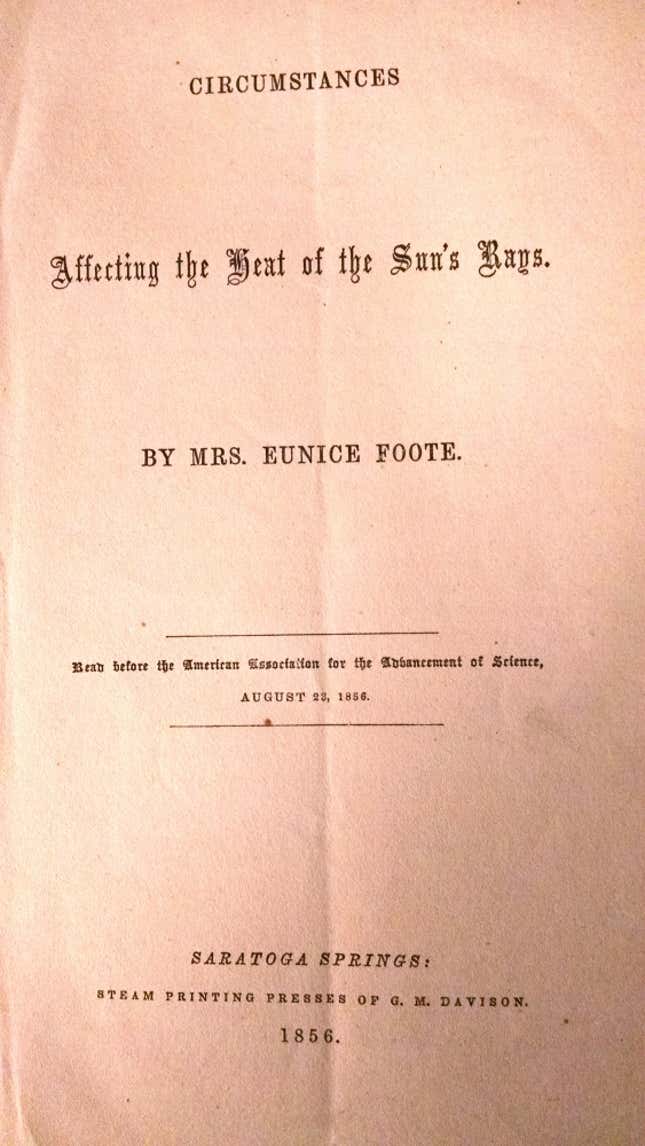John Tyndall, an Irish physicist, is usually recognized as the first person to prove the greenhouse-gas effect. But some of the credit should have gone to Eunice Foote, an American scientist, who, save a few mentions, remains largely unknown today.
To correct the scientific wrong, the University of California-Santa Barbara (UCSB) is organizing an event titled: “Science knows no gender? In search of Eunice Foote, who 162 years ago discovered the principal cause of global warming” on May 17. Foote’s story was first brought to light by Raymond Sorenson, an independent researcher, in 2011. Since then, UCSB researcher John Perlin has unearthed more details.
Foote was born in Connecticut in 1819 and grew up in Troy, New York. She came by her scientific education, unusual for a woman in that time and place, through a stroke of good fortune. According to the Santa Barbara Independent:
Foote attended Troy Female Seminary, whose students were invited to attend a nearby science college started by a character named Amos Eaton. He was a convicted con man who’d been sentenced to life in prison, but was released after four years so he could pursue his life calling as an evangelist of scientific education. Apparently he hadn’t been told women couldn’t be scientists, so Foote was able to learn the nuts and bolts of chemistry and experimental techniques at his school.
She then married a judge, who was an amateur scientist himself, and built a lab to continue experimenting at home. She was especially curious about what happened to gases when they trapped the sun’s heat, which is something only a handful of scientists, such as Joseph Fourier, had done theoretical work on. The Smithsonian describes the scientific details of the experiment that helped her make the discovery, which was later published in a study:
Foote’s paper demonstrated the interactions of the sun’s rays on different gases through a series of experiments using an air pump, four thermometers, and two glass cylinders. First, Foote placed two thermometers in each cylinder and, using the air pump, removed the air from one cylinder and condensed it in the other. Allowing both cylinders to reach the same temperature, she then placed the cylinders with their thermometers in the sun to measure temperature variance once heated and under various states of moisture. She repeated this process with hydrogen, common air, and CO2, all heated after being exposed to the sun.
In 1856, Foote submitted her results to the Eighth Annual Meeting of the American Association for the Advancement of Science (AAAS). Unlike most scientific societies of the time, the AAAS actually permitted female members, but it would not give them the title of professional or fellow. It meant Foote could submit her results but not present them, according to the Smithsonian. But there’s no proof that such a policy was in effect, contends Katharine Hayhoe of Texas Tech University.
In her place, John Henry of the Smithsonian Institution read the paper, acknowledged it to be Foote’s work, and added his own preface to it: “Science was of no country and of no sex. The sphere of woman embraces not only the beautiful and the useful, but the true.”

The research was published later the same year with her name as the author in the American Journal of Arts and Science. The same edition of the journal carried a paper by John Tyndall on color blindness.
Three years later, Tyndall reported his own results investigating how different gases trapped the sun’s heat reflected by the Earth in the Proceedings of the Royal Society, where he was a fellow. “We know nothing of the effect even of air upon heat radiated from terrestrial sources,” he wrote in 1859 in his submission. “With regard to the action of other gases upon heat, we are not, so far as I am aware, possessed of a single experiment.” And thus not acknowledging, knowingly or otherwise, Foote’s work on the subject.
Climate experts say that Foote did not technically prove the greenhouse-gas effect, which results from the gases in the atmosphere trapping the sun’s heat that is reflected by the Earth in the form of infrared radiation. “For that reason her conclusion, that carbon dioxide traps more heat than the other gases she measured, is more serendipitous then evidential,” Hayhoe wrote on Facebook. “Her hypothesis, however, that long-term changes in atmospheric carbon dioxide levels could affect the temperature of the Earth, was remarkably prescient.”
Tyndall’s work was indeed more comprehensive and sophisticated—not surprising given his more thorough scientific training and access to resources through universities he worked at—than Foote’s work and has played an important part in our understanding of climate change. But Tyndall’s omission in that 1859 paper “was a crime of science,” Perlin told the Santa Barbara Independent. “Tyndall claimed no one had done this work before. He was a great omitter.”
Even before her study was published, Foote was a part of the women’s-rights movement growing at the time. But it’s not known what happened to her after 1856, and no other scientific papers were published under her name. “Who knows what she would have achieved if she’d had Tyndall’s advantages?” asks Hayhoe.
Tyndall wasn’t the first man to omit a woman’s work and he would not be the last. More than a century later, Rosalind Franklin would be crucial to discovering the structure of DNA but wouldn’t get enough credit. And a decade before Foote, Ada Lovelace became the world’s first computer programmer. But people continue to argue—despite strong evidence to the contrary—that Lovelace wasn’t the first. And that’s exactly why it’s worth celebrating what Foote, Lovelace, and Franklin did, because there are countless other women who deserve credit but whose names we may never hear about.
This article was updated to better reflect the differences in the scientific achievements of Foote and Tyndall.
